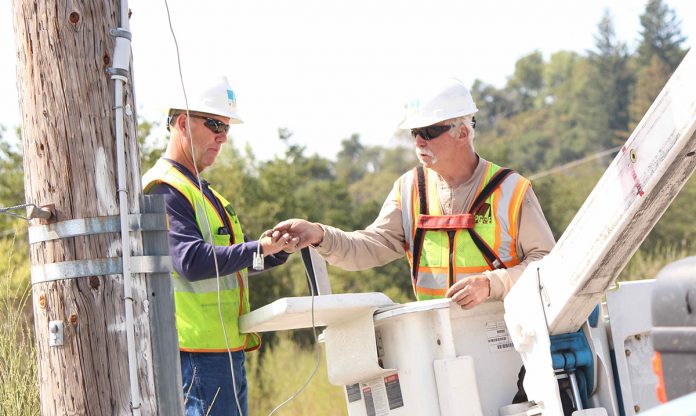The San Lorenzo Valley has been plagued with power outages for as long as the area has had electricity.
Strong winds, downed trees and mudslides have taken out power time and again, and residents of the area recognize that living beneath the redwoods has its price.
In October of 2019, Pacific Gas and Electric Company (PG&E) began the practice of implementing PSPS outages—Public Safety Power Shutoffs—in an effort to arrest the potential of massive and deadly wildfires caused by arcing power lines in heavy winds.
The implementation of the PSPS was in response to the utility’s role in two fire events, the October 2017 Northern California wildfires and the 2018 Camp Fire, both of which were started by PG&E’s equipment. Adding fuel to the fire, the utility was recently charged with manslaughter in the case of four deaths from the 2020 Zogg Fire near Redding. The ignominy of being responsible for hundreds of millions of dollars worth of community devastation and the loss of lives required PG&E to do something different.
Enter Enhanced Powerline Safety Settings (EPSS) and the use of “fast trip” switches, a technology meant to shut off power when the lines are met with a potential hazard. By employing these switches, the utility can ostensibly reduce the chance of a power line-induced fire, and preserve the safety of the surrounding area.
At least, that’s what attendees of the Sept. 23 wildfire safety webinars were told. PG&E hosted the two live webinars—one for the Corralitos/Watsonville area and another for the San Lorenzo Valley—in an attempt to answer questions and provide some transparency to the process.
According to PG&E spokesperson Mayra Tostado, 469 local residents attended the SLV presentation, and more than 300 questions and comments were submitted during the 90-minute virtual meeting. With representatives of the utility attempting to explain the reasons for the dramatic increase of power outages in the area, attendees listened to nearly an hour of corporate-speak interspersed with the recognition that the utility has fallen down on the job when it comes to communicating with residents about impending power outages, the cause and restoration times.
PG&E representatives said that squirrels were a factor in the repeated outages, as their movement across the lines can cause the fast trip feature to engage. In addition, a slight breeze or a falling tree branch could provoke an outage, leaving hundreds on the circuit without power for hours.
“We recognize the hardship Enhanced Powerline Safety Settings power outages cause our customers and are making a number of improvements that will lessen the impact of EPSS on customers,” said Tostado.
That includes, Tostado said, adjusting the software of the EPSS to lessen the size and time of the outages. She also said that customers should proactively contact the utility if they see any unsafe conditions around power lines.
Teresa Alvarado, Vice President of the South Bay and Central Coast Regions for PG&E, covered the basics on outages in the San Lorenzo Valley.
Estimates were that 34 outages had occurred in the area since July, with 10-12 hours of lost power over those instances. It was unclear whether Alvarado was suggesting that those numbers reflected the average amount of hours without power, or the total hours.
Residents who attended the webinar were hoping to not only get answers about future efforts to mitigate power outages, but they also wanted the opportunity to voice their concerns about the impacts of prolonged outages. Worries about rotting food, loss of income for those working from home, and the inability to operate medical devices were front and center for many on the call.
The response was that the utility would not compensate ratepayers for financial hardships caused by power outages. Instead, PG&E reps directed customers to contact local food banks, and suggested that seniors could receive two meals per day from Meals on Wheels (a service that is already provided by nonprofit Community Bridges).
“Customers in our Medical Baseline Program who live in high fire-threat areas may be eligible for our Portable Battery Program. We also have a Generator Rebate Program for customers who rely on well water, customers in our Medical Baseline Program and certain small businesses,” said Tostado, and directed ratepayers to the PG&E website.
Rob Morris, an Alarm Station Operator with the utility, said that there are 800 circuits in high fire threat districts, but PG&E chose to address issues with the 169 circuits that feed into and around the South Bay region. They were chosen, he said, based on a risk model and the public safety specialist team that is made up, in part, of first responders. The circuits’ proximity to flammable material increased the need for critical attention, and Morris said he committed to a “strategic approach” to improve reliability within the next 15 days when it comes to addressing outages that affect our communities.
Fifth District Supervisor Bruce McPherson said that both he and 2nd District Supervisor Zach Friend had lobbied for the utility to hold the webinar in response to public outrage over the repeated outages, and McPherson had requested the opportunity to speak and pose questions during the webinar. According to McPherson’s Analyst JM Brown, the requests were denied. Despite his initial support for the event, McPherson was less than pleased by the outcome.
“I was disappointed that PG&E chose not to have a direct dialogue with customers in the San Lorenzo Valley, as I had requested, and instead simply read questions,” he said in a statement. “PG&E representatives acknowledged during the meeting that they greatly needed to improve their communications with customers, but missed a good opportunity to do that very thing. While the presentation helped the community better understand the problem with the fast trip setting, I didn’t come away with the impression that people understand how it will be fixed in the long-term.”
Supervisors McPherson and Friend placed an item on the agenda of the Board of Supervisors’ Tuesday meeting calling for the Public Utilities Commission to investigate the outages. It passed unanimously.
To view the webinar, visit wklys.co/PGE2140.









